Red Lady Papaya, also known as Carica papaya ‘Red Lady,’ is a tropical fruit tree that belongs to the Caricaceae family. This variety of papaya is highly sought for its compact size and fast-growing nature. By providing essential nutrients, fertilizers ensure the plant has everything it needs to thrive and produce healthy fruits.
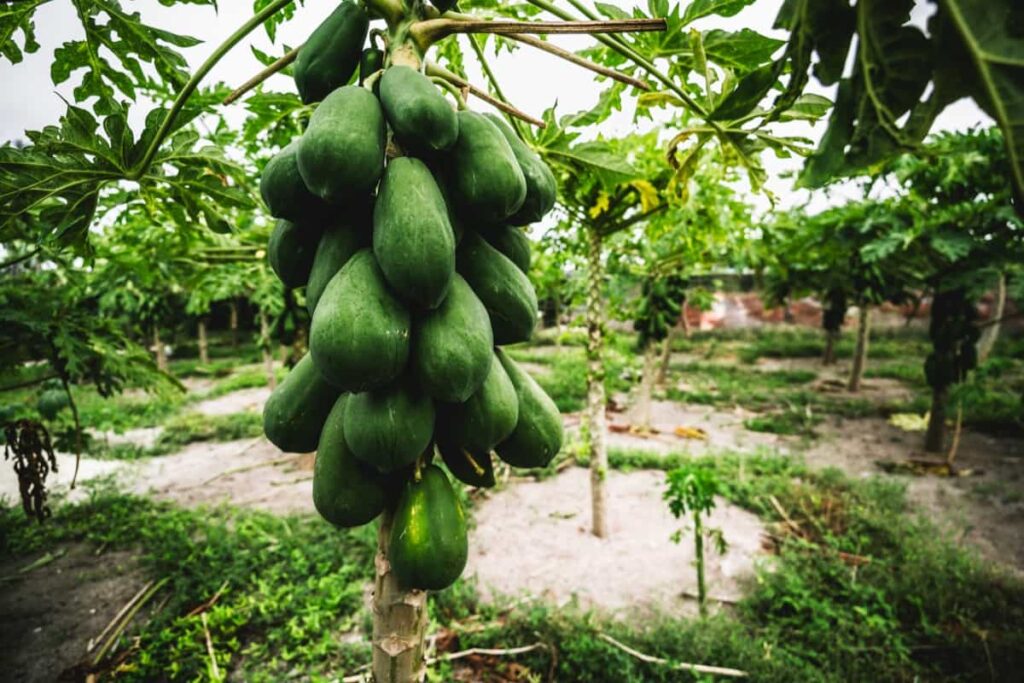
Best Fertilizer for Red Lady Papaya
Understanding the Importance of Fertilizing Red Lady Papaya: A Comprehensive Guide
Proper fertilization promotes vigorous plant growth. Red Lady Papayas require a balanced supply of macronutrients such as N, P, and K to develop strong stems, abundant foliage, and robust root systems. The main reason fertilizers are important for Red Lady Papaya is because it helps maintain optimal soil fertility. This is particularly important in areas where the soil may lack certain nutrients necessary for plant growth.
Fertilizers help replenish these nutrients, ensuring the papaya plants can access all they need. Another reason why fertilizer is vital for Red Lady Papaya is that it promotes strong root development. Healthy roots are essential for nutrient absorption and water uptake, allowing the plants to establish themselves in the ground and withstand environmental stressors.
Organic Fertilizers for Red Lady Papaya: Benefits and Recommendations
The main advantage of using organic fertilizers for Red Lady Papaya is that they provide a slow release of nutrients, ensuring a steady supply over an extended period. This helps avoid nutrient imbalances or excesses that can harm the plants. Furthermore, organic fertilizers enrich the soil by increasing its microbial activity and improving its structure.
In case you missed it: Optimizing Papaya Orchard Management: A Month-by-Month Operations Guide for Maximum Yield
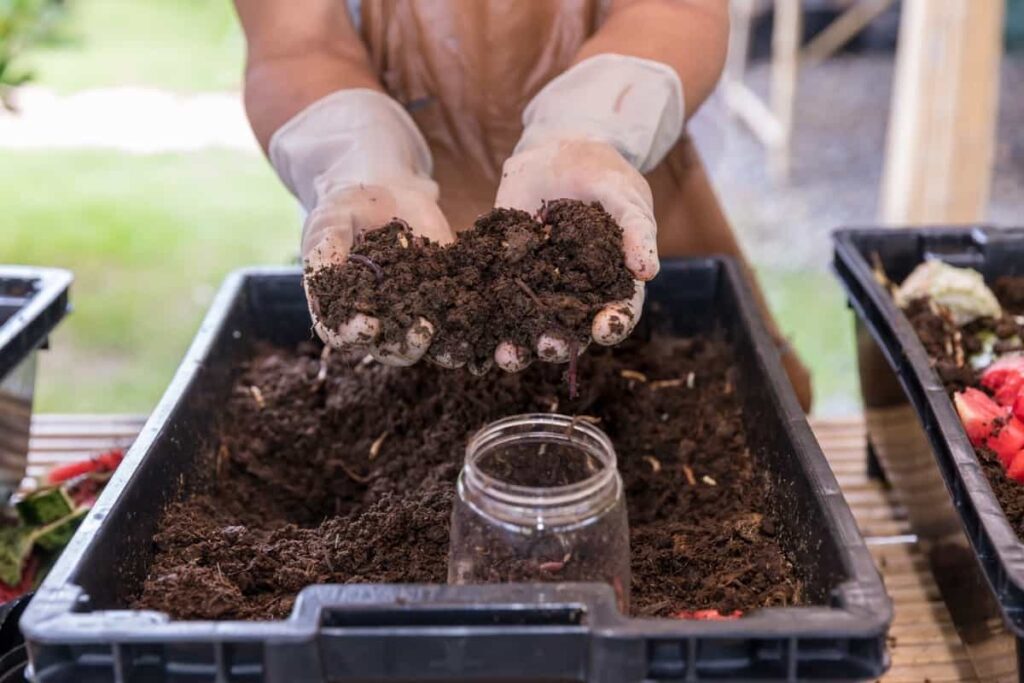
This leads to better water retention, nutrient absorption, and root development – all essential for healthy papaya growth. Compost is the best option for organic fertilizer from yard waste, kitchen scraps, and other organic materials. Compost enriches the soil with vital nutrients, improves its structure, and helps retain moisture – key factors in promoting healthy growth for your Red Lady Papaya trees.
Another great organic fertilizer for Red Lady Papaya is vermicompost or worm castings. These little wriggly creatures break down organic matter into nutrient-rich castings that provide abundant nitrogen, phosphorus, potassium, and beneficial microorganisms. Applying vermicompost around the base of your Red Lady Papaya plants will give them a much-needed boost.
Natural Fertilizers for Red Lady Papaya: Enhancing Growth and Yield
- Fish Emulsion: Made from fish waste products, fish emulsion is a nutritious liquid fertilizer rich in nitrogen and micronutrients like phosphorus and potassium. Dilute fish emulsion with water according to package instructions before applying it to your papaya plants.
- Banana Peels: They contain high potassium levels, which promotes flowering and fruit production in papayas. Chop up banana peels into small pieces and bury them around the base of your Red Lady Papaya trees.
- Epsom Salt Solution: Epsom salt is rich in magnesium sulfate, which aids in chlorophyll production and overall plant health.
- Seaweed Extracts: Seaweed extracts contain essential minerals such as calcium, iron, zinc, and manganese that stimulate root development and boost plant growth.
Homemade Fertilizers for Red Lady Papaya: Cost-effective and Environmentally Friendly Options
One popular homemade fertilizer for Red Lady Papaya is compost tea. This liquid is made by steeping compost in water for some time. As the organic matter breaks down, it releases some essential nutrients that the plant roots can easily absorb. Another great option is banana peel fertilizer. Instead of throwing away those banana peels, chop them into small pieces and bury them around the base of your papaya plant. Over time, they will decompose and release potassium, phosphorus, and other beneficial minerals.
Consider using coffee grounds if you want a quick nitrogen boost for your papayas. Sprinkle used coffee grounds around the plant base or mix them into the soil. Not only will this provide an instant nutrient boost, but it can also improve soil structure. Eggshells are another fantastic homemade fertilizer option as they are rich in calcium, promoting healthy root development in papaya plants. Crushed eggshells can be sprinkled directly onto the soil or mixed with water to create a calcium-rich solution.
In case you missed it: High-yield Hybrid Papaya Varieties in India: How to Grow, Fertilizers, Pests, and Diseases
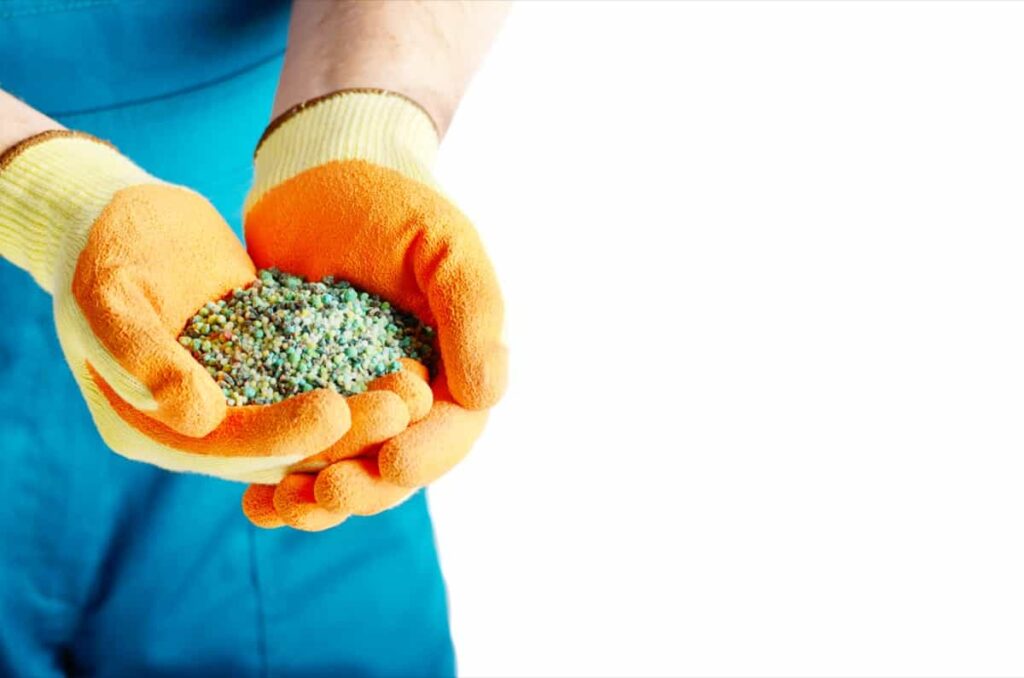
NPK Ratio for Red Lady Papaya: Finding the Right Balance for Optimal Growth
A balanced NPK ratio for Red Lady Papaya is 14:14:14 is recommended. Using a fertilizer with an NPK ratio of 14:14:14 or similar proportions ensures that your Red Lady Papaya receives a balanced supply of these essential nutrients. This will help promote plant growth and maximize fruit production without causing imbalances or deficiencies.
The Role of Nitrogen in Fertilizing Red Lady Papaya: Dosage and Application Methods
It is an essential nutrient that promotes leafy green foliage, robust stems, and overall plant vigor. However, applying nitrogen fertilizer in the right dosage and using appropriate application methods is key to preventing overfertilization or nutrient imbalance. When dosing nitrogen for Red Lady Papayas, it’s important to strike a balance. Too much nitrogen for Red Lady Papaya can result in excessive vegetative growth. On the other hand, insufficient nitrogen can lead to weak plants with stunted growth.
For optimal results, apply nitrogen fertilizer during periods of active growth when the papaya plants are actively producing new leaves and stems. Splitting the application into smaller doses throughout the growing season ensures a steady supply without overwhelming the plants. There are various application methods you can use for nitrogen fertilization. Broadcasting granular fertilizer around each tree’s drip line is a common technique. Alternatively, you can opt for liquid fertilizers applied directly to the soil or foliar spray applications on leaves.
Phosphorus Requirements for Red Lady Papaya: Promoting Root Development and Flowering
It is an essential nutrient that promotes root development and flowering, ultimately leading to a higher yield of delicious papayas. Red Lady Papaya’s phosphorus requirements finding the right balance is important. Too little phosphorus can result in stunted growth and poor flower production, while excess phosphorus may lead to nutrient imbalances and environmental pollution.
Consider using organic fertilizers such as bone meal or rock phosphate to ensure optimal phosphorus levels. These natural sources provide a slow-release form of phosphorus readily available to the plants without causing any harm. Applying phosphorous-rich fertilizer during the early stages of plant growth will help establish strong roots, enabling the tree to absorb water and nutrients more efficiently. Continued supplementation will stimulate flower formation as the plant matures, leading to abundant fruiting.
Potassium and its Impact on Red Lady Papaya Growth: Ensuring Fruit Quality and Disease Resistance
It is an essential nutrient contributing to plant health, fruit quality, and disease resistance. One significant impact of potassium on Red Lady Papaya growth is its ability to enhance root development. In addition, potassium also helps regulate various physiological processes within the plant.
In case you missed it: Plant Spacing Chart for Vegetables, Fruits, Flowers, Herbs and Calculate Ideal Plant Spacing
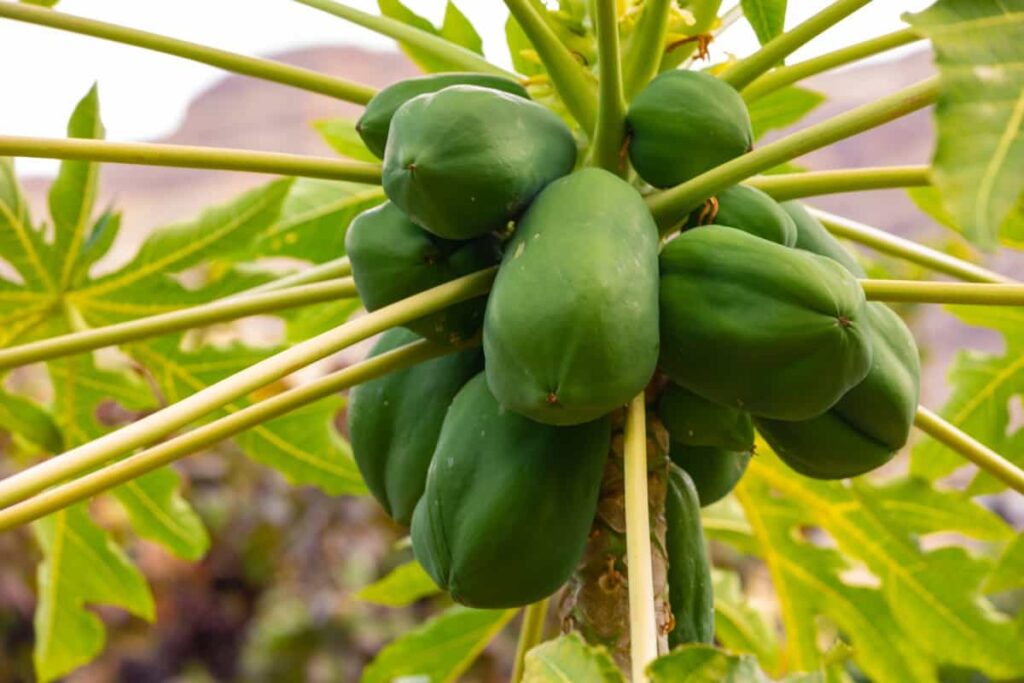
It aids in photosynthesis, ensuring optimal fruit formation and growth energy production. This ultimately leads to better fruit quality with desirable taste, texture, color, and size attributes. Furthermore, potassium plays a vital role in strengthening the immune system of Red Lady Papaya plants. Adequate levels of this nutrient helps improve disease resistance by enhancing cell wall structure and activating defense mechanisms against pathogens.
Micronutrients for Red Lady Papaya: Essential Elements for Healthy Plant Development
One micronutrient for Red Lady Papaya is iron, which aids in chlorophyll production and photosynthesis. Without sufficient iron, Red Lady Papaya leaves may turn yellow due to chlorosis. Manganese is another micronutrient that helps with enzyme activation and energy metabolism within the plant cells.
Zinc is another critical micronutrient for Red Lady Papaya plants as it promotes hormone synthesis and enhances flowering and fruit set. Copper plays a vital role in various enzymatic plant growth and development reactions. Boron is also necessary to form cell walls and properly pollinate Red Lady Papaya plants.
It improves nutrient uptake efficiency by facilitating root elongation. To ensure optimal levels of these micronutrients, it is important to provide regular fertilization with balanced organic or natural fertilizers containing trace elements. Soil tests can help determine any deficiencies so you can adjust your fertilization program accordingly.
Best Time to Fertilize Red Lady Papaya: A Seasonal Schedule for Maximum Effectiveness
For young trees, it is recommended to fertilize every 14 days during their initial stages of growth. This frequent application ensures they receive a steady supply of nutrients for healthy development. Regular fertilization will promote strong and vigorous growth as these trees still establish their root systems. On the other hand, established Red Lady Papaya plants require less frequent fertilization. Fertilizing every other month is sufficient to maintain their nutritional needs. These mature plants have well-established root systems and can efficiently absorb nutrients from the soil.
Pre-Planting Fertilization Techniques for Red Lady Papaya: Setting the Foundation for Success
One important technique is soil testing. Testing your soil’s nutrient levels before planting your Red Lady Papaya seeds or seedlings. This will help you determine which specific nutrients may be lacking and allow you to tailor your fertilizer application accordingly. Amend the soil with organic matter based on your soil test results. These amendments provide essential nutrients and improve soil structure and water-holding capacity.
Additionally, consider incorporating a slow-release fertilizer into the planting hole. Slow-release fertilizers gradually release nutrients, ensuring a steady supply throughout the growing season. Using phosphorus-rich fertilizers like bone meal or rock phosphate further enhances nutrient availability during early growth. Phosphorus promotes strong root development and flowering in Red Lady Papaya plants.
Foliar Feeding of Red Lady Papaya: Supplementing Nutrients through Leaf Application
Foliar feeding is an effective technique for providing essential nutrients to Red Lady Papaya plants through leaf application. By spraying a nutrient solution directly onto the leaves, the plant can quickly absorb and utilize these nutrients for improved growth and development. The main benefit of foliar feeding is its ability to bypass soil-related issues that may hinder nutrient uptake.
In case you missed it: 12 Best Fig Tree Fertilizers: Top Organic Fruit Tree Fertilizers Along with Price
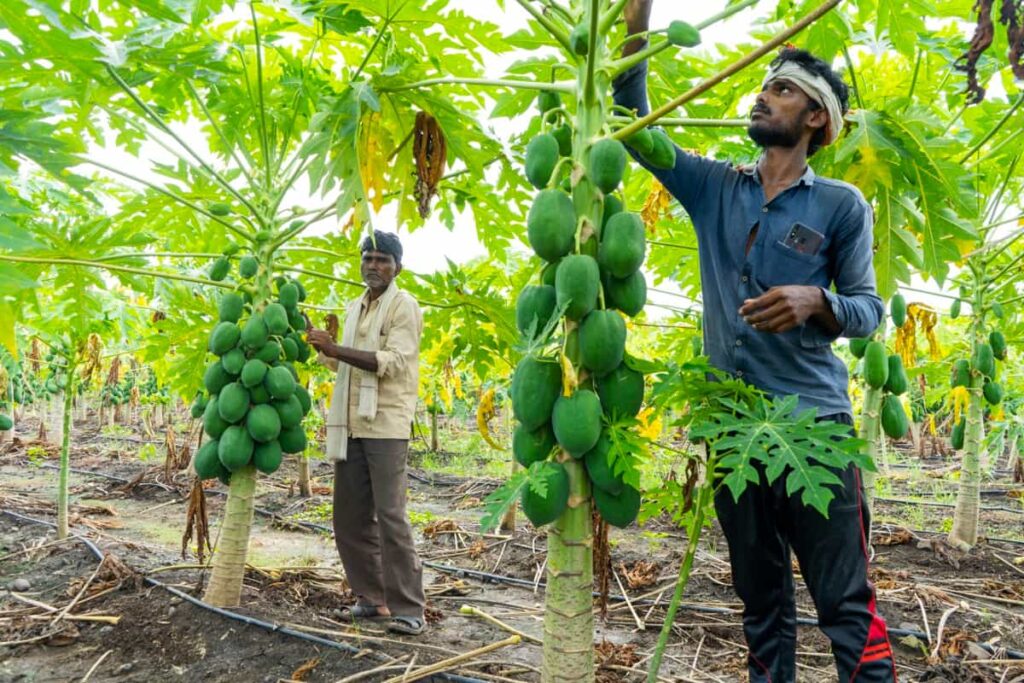
Sometimes, even with proper fertilization, certain soil conditions can limit the roots’ availability or absorption of nutrients. Foliar feeding allows you to directly supply those much-needed elements without relying solely on root uptake. When applying foliar sprays to Red Lady Papaya plants, choosing a balanced fertilizer solution specifically formulated for foliar application is important. Additionally, it’s crucial not to exceed recommended dosage rates when using foliar fertilizers.
Soil Amendments for Red Lady Papaya: Improving Soil Health and Nutrient Availability
Healthy, nutrient-rich soil provides a solid foundation for the plant to thrive and produce abundant fruits. Incorporating organic amendments into the soil can be highly beneficial to improve soil health and nutrient availability. Additionally, these amendments contribute essential nutrients slowly released over time as they break down. This gradual release ensures a steady supply of nutrients to nourish the papaya plants throughout their growth cycle.
Another effective way to amend the soil for Red Lady Papaya is by adding natural minerals like rock phosphate or gypsum. These minerals provide important macronutrients like phosphorus and help adjust pH levels in acidic soils. Incorporating green manures or cover crops into the rotation can also be an excellent practice for enriching the soil.
Leguminous cover crops like clover or vetch fix nitrogen from the atmosphere, replenishing this vital nutrient in deficient soils. Regularly testing your soil’s nutrient content will guide you on which specific amendments are needed based on deficiencies identified. Addressing these deficiencies through targeted amendments ensures that your Red Lady Papaya plants can access all necessary nutrients for robust growth and fruit production.
Slow-Release Fertilizers for Red Lady Papaya: Long-lasting Nutrient Supply for Sustained Growth
One popular type of slow-release fertilizer for Red Lady Papaya is coated granules, which have a special coating that controls the release rate of nutrients. Another option is organic slow-release fertilizers from natural materials such as compost or manure. Additionally, these fertilizers require fewer applications than traditional water-soluble ones since they provide nutrients over an extended period. This saves time and effort in maintaining your Red Lady Papaya plants while ensuring optimal growth and yield.
Fertilizer Application Techniques for Red Lady Papaya: Tips and Tricks for Efficient Nutrient Uptake
Soil Testing: Before applying any fertilizer, it’s essential to test the soil nutrients and pH levels. This will provide valuable insights into which nutrients are deficient and guide your fertilizer selection.
Proper Timing: Apply fertilizers during the early morning or late evening when temperatures are cooler. This helps prevent nutrient loss due to evaporation and ensures better absorption by the plant roots.
Avoid Overapplication: It may be tempting to apply more fertilizer, thinking it will promote faster growth. However, overapplication can lead to nutrient imbalances or even burn the plant roots. Follow recommended dosage guidelines for best results.
Uniform Distribution: Ensure an even spread of fertilizer throughout the planting area using a broadcast method or targeted placement around each plant’s drip line. This helps ensure all plants receive adequate nutrients for healthy growth.
Deep Root Feeding: For established Red Lady Papaya plants, deep root feeding is beneficial as it delivers nutrients directly to where they’re needed most – the root zone.
Watering After Application: After applying fertilizers, water thoroughly to aid in nutrient absorption by the roots and prevent potential damage caused by concentrated salts from fertilizers.
In case you missed it: [15 Best Apple Tree Fertilizers: Liquid and Organic Nutrients for Healthy Fruit Yield
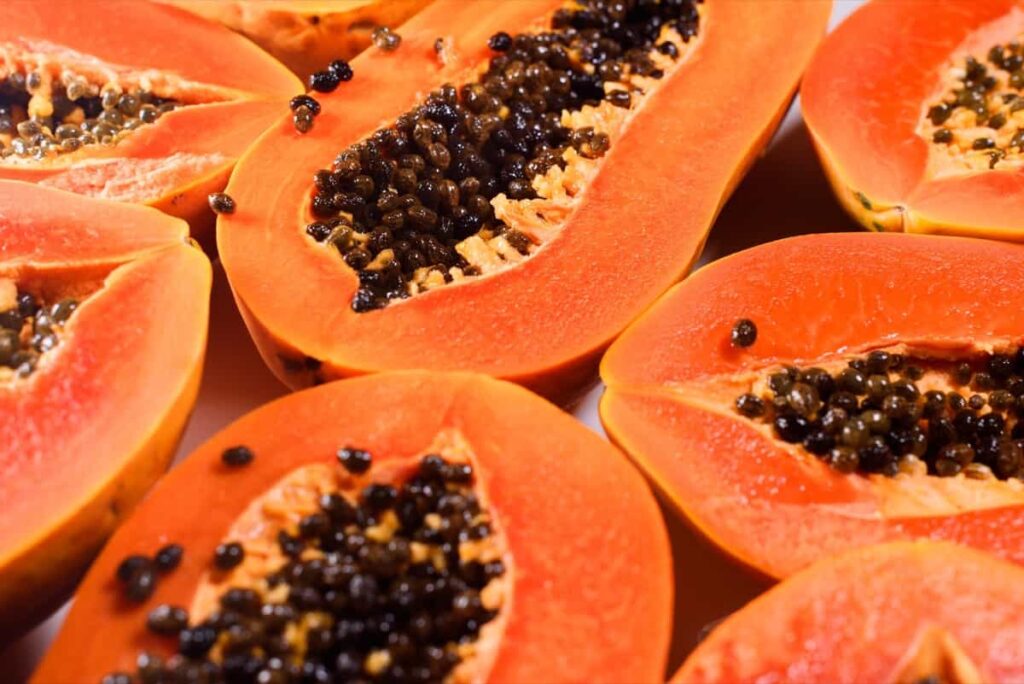
Schedule of Fertilizers for Red Lady Papaya
| Different Plant Stages | Fertilizer Application |
| Pre-Planting | Organic matter (compost) Phosphorus-rich fertilizer Potassium-rich fertilizer Micronutrient supplement (if needed) |
| Young Trees | Fertilize every 14 days with NPK 14:14:14 or organic alternatives |
| Established Plants | Fertilize every other month with NPK 14:14:14 or organic alternatives |
| Monthly Supplement for Minor Elements | Include zinc and manganese supplements once per month |
Conclusion
Fertilizing plays a crucial role in the growth and development of Red Lady Papaya plants. By providing essential nutrients, fertilizers can help boost plant health, increase fruit production, and improve overall yield. Furthermore, fertilizers play a significant role in enhancing fruit quality and yield. They provide key elements such as potassium, contributing to proper fruit formation, size, coloration, and taste. Additionally, fertilizers can help improve disease resistance by strengthening the plant’s health.
- Sheep Farming Business Plan for Beginners
- Aquaponic Farming at Home: A Step-By-Step Guide
- Profitable Village Farming Business Ideas in 2024
- High-Yield Aquaculture: Fast-Growing Fish for Farming
- Effective Fish Pond Construction Techniques for Beginners
- Irrigation and Water Management in Pineapple Farming
- Blossom to Harvest: Mastering Flowering and Pollination in Papaya Farming
- Pig Fattening Essentials: From Selection to Sale for Beginners
- Raising Wagyu Cattle: A Complete Guide for Premium Beef Production
- Soil Types and Their Water Holding Capacity
- Optimizing Irrigation Schedules for Coconut Groves for Enhanced Yield
- Espresso Your Garden: Coffee Grounds for Healthier Acid-Loving Plants
- The Best Soil Mix for Snake Plants: How to Mix Your Own Snake Plant Soil
- Green Thumb Success: Expert Tips for Cultivating Greenhouse Beans All Year Round
- Bloom All Year Round: The Ultimate Guide to Indoor Hyacinth Care
- Eco-Friendly Gardening: How to Make Liquid Fertilizer from Kitchen Waste
- Ultimate Guide to Grow Anise in Pots: Explore Seed Propagation to Harvesting
- Guide to Raising Chester White Pigs: Discover Breed Facts to Growth Management
- Mastering the Elegance: The Ultimate Guide to Weeping Cherry Tree Care, Planting, and Maintenance
- Ultimate Guide to Planting Garlic in Grow Bags: Growing Strategies for Beginners
- How to Fix Spider Plant Leaf-Related Problems: Natural and Organic Remedies
- 10 Reasons Why Your Tulsi Plant is Shedding Leaves: Home Remedies and Solutions
- Optimizing Growth and Yield: The Advantages of Palm Bunch Ash Fertilizer
- Utilizing Neem Oil Extract as a Natural Pesticide for Hydrangea
- From Soil to Harvest: Various Ways in Which Farmers Can Use AI Tools
- Steps to Encourage and Induce Citrus Flowers: A Comprehensive Guide
- How to Fix Snake Plant Leaf-Related Issues: Natural and Organic Remedies
- Transform Your Garden into a Fragrant Oasis with Raat Ki Rani (Night Blooming Jasmine)
- Discover the Ideal Chicken Breeds for Philippine Farms
- How to Create a Poultry Egg Farm Business Plan for Profits
- Grow Lemon Cucumbers Like a Pro: Insider Techniques for Bountiful Yields
- Ultimate Guide to Caring for Your Pink Princess Philodendron: Tips for Thriving Variegation
- Areca Nut Profit Per Acre: Calculating Yield and Cost of Cultivation
- How Kaveri Chicken is Becoming a More Profitable Breed in Indian Backyards
- Transform Your Barn: 9 Steps to Convert a Horse Stall into a Chicken Coop
- Exploring Suffolk Sheep Disadvantages with Limitations and Challenges

Great to come up with great idea and innovative way forward for papaya farming..we are here in the tropics and planting this with pineapple will be great benefit especially with the great sun and soil here in Suva, Fiji.Thank you n best papaya farming.